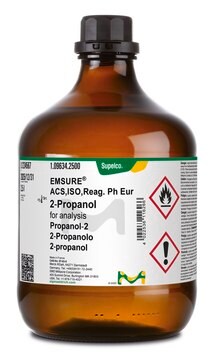320048
2-Methyl-1-propanol
ACS reagent, ≥99.0%
Sinônimo(s):
Isobutanol, Isobutyl alcohol
About This Item
Produtos recomendados
grau
ACS reagent
densidade de vapor
2.55 (vs air)
pressão de vapor
8 mmHg ( 20 °C)
8.8 mmHg ( 0 °C)
Ensaio
≥99.0%
Formulário
liquid
temperatura de autoignição
801 °F
Lim. expl.
10.6 %
dilution
(for analytical testing)
Impurezas
≤0.0005 meq/g Titr. acid
≤0.01% butyraldehyde
≤0.02% 2-butanone
≤0.1% water
resíduo de evaporação
≤0.001%
cor
APHA: ≤10
índice de refração
n20/D 1.396 (lit.)
p.e.
108 °C (lit.)
pf
−108 °C (lit.)
densidade
0.803 g/mL at 25 °C (lit.)
cadeia de caracteres SMILES
CC(C)CO
InChI
1S/C4H10O/c1-4(2)3-5/h4-5H,3H2,1-2H3
chave InChI
ZXEKIIBDNHEJCQ-UHFFFAOYSA-N
Procurando produtos similares? Visita Guia de comparação de produtos
Categorias relacionadas
Palavra indicadora
Danger
Frases de perigo
Declarações de precaução
Classificações de perigo
Eye Dam. 1 - Flam. Liq. 3 - Skin Irrit. 2 - STOT SE 3
Órgãos-alvo
Central nervous system, Respiratory system
Código de classe de armazenamento
3 - Flammable liquids
Classe de risco de água (WGK)
WGK 1
Ponto de fulgor (°F)
82.4 °F - closed cup
Ponto de fulgor (°C)
28 °C - closed cup
Escolha uma das versões mais recentes:
Já possui este produto?
Encontre a documentação dos produtos que você adquiriu recentemente na biblioteca de documentos.
Os clientes também visualizaram
Nossa equipe de cientistas tem experiência em todas as áreas de pesquisa, incluindo Life Sciences, ciência de materiais, síntese química, cromatografia, química analítica e muitas outras.
Entre em contato com a assistência técnica












